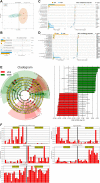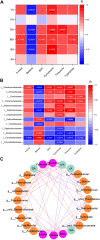Associations between dysbiosis gut microbiota and changes of neurotransmitters and short-chain fatty acids in valproic acid model rats
- PMID: 37035670
- PMCID: PMC10073564
- DOI: 10.3389/fphys.2023.1077821
Associations between dysbiosis gut microbiota and changes of neurotransmitters and short-chain fatty acids in valproic acid model rats
Abstract
Introduction: The microbiota-gut-brain axis plays an important role in the pathophysiology of autism spectrum disorder, but its specific mechanisms remain unclear. This study aimed to explore the associations of changes in neurotransmitters and short-chain fatty acids with alterations in gut microbiota in valproic acid model rats. Methods: The autism model rats were established by prenatal exposure to valproic acid (VPA). The Morris water maze test, open field test, and three-chamber test were conducted to assess the behaviors of rats. 16S rRNA gene sequences extracted from fecal samples were used to assess the gut microbial composition. Gas and liquid chromatography-mass spectroscopy was used to identify short-chain fatty acids in fecal samples and neurotransmitters in the prefrontal cortex (PFC). Results: The results showed that 28 bacterial taxa between valproic acid model rats and control rats were identified, and the most differential bacterial taxa in valproic acid model rats and control rats belonged to metagenomic species and Lactobacillus intestinalis. Acetic acid, butyric acid, valeric acid, isobutyric acid, and isovaleric acid were significantly decreased in the valproic acid model rats compared to those in control rats. Five neurotransmitters (threonine, kynurenine, tryptophan, 5-hydroxyindoleacetic acid, denoted as 5-HIAA, and betaine aldehyde chloride, denoted as BAC) were significantly decreased, whereas betaine was increased in the prefrontal cortex of valproic acid model rats compared to control rats. A variety of neurotransmitters (≥4) were correlated with Pseudomonas, Collisella, and Streptococcus at the genus level, and they were also related to the decrease of short-chain fatty acids. Discussion: According to this study, we can preliminarily infer that gut microbiota or their metabolic productions (such as SCFAs) may influence central neurotransmitter metabolism through related pathways of the gut-brain axis. These results provide microbial and short-chain fatty acid (SCFA) frameworks for understanding the role of the microbiota-gut-brain axis in autism spectrum disorder and shed new light on autism spectrum disorder treatment.
Keywords: autism spectrum disorder; microbiota; neurotransmitter; short-chain fatty acids; valproic acid.
Copyright © 2023 Zhong, Lan, Feng, Li, Shen, Gong, Zou and Hou.
Conflict of interest statement
The authors declare that the research was conducted in the absence of any commercial or financial relationships that could be construed as a potential conflict of interest.
Figures





Similar articles
-
Associations between disordered gut microbiota and changes of neurotransmitters and short-chain fatty acids in depressed mice.Transl Psychiatry. 2020 Oct 16;10(1):350. doi: 10.1038/s41398-020-01038-3. Transl Psychiatry. 2020. PMID: 33067412 Free PMC article.
-
Microbiota-derived short-chain fatty acids may participate in post-stroke depression by regulating host's lipid metabolism.J Psychiatr Res. 2023 May;161:426-434. doi: 10.1016/j.jpsychires.2023.03.032. Epub 2023 Apr 4. J Psychiatr Res. 2023. PMID: 37031497
-
Disrupted gut harmony in attention-deficit/hyperactivity disorder: Dysbiosis and decreased short-chain fatty acids.Brain Behav Immun Health. 2024 Jul 27;40:100829. doi: 10.1016/j.bbih.2024.100829. eCollection 2024 Oct. Brain Behav Immun Health. 2024. PMID: 39184374 Free PMC article.
-
Overlapping Mechanisms of Action of Brain-Active Bacteria and Bacterial Metabolites in the Pathogenesis of Common Brain Diseases.Nutrients. 2022 Jun 27;14(13):2661. doi: 10.3390/nu14132661. Nutrients. 2022. PMID: 35807841 Free PMC article. Review.
-
The Possible Role of the Microbiota-Gut-Brain-Axis in Autism Spectrum Disorder.Int J Mol Sci. 2019 Apr 29;20(9):2115. doi: 10.3390/ijms20092115. Int J Mol Sci. 2019. PMID: 31035684 Free PMC article. Review.
Cited by
-
Effect of Dietary Sugarcane Bagasse on Reproductive Performance, Constipation, and Gut Microbiota of Gestational Sows.Animals (Basel). 2024 Aug 30;14(17):2523. doi: 10.3390/ani14172523. Animals (Basel). 2024. PMID: 39272308 Free PMC article.
-
The Interplay Between Exosomes and Gut Microbiota in Neuroinflammation: A New Frontier in Alzheimer's Disease.Int J Mol Sci. 2025 Jun 18;26(12):5828. doi: 10.3390/ijms26125828. Int J Mol Sci. 2025. PMID: 40565291 Free PMC article. Review.
-
Mitochondrial protection and anti-inflammatory effect of curcumin in inhibiting reproductive toxicity induced by sodium valproate in male mice.Iran J Basic Med Sci. 2025;28(8):1027-1036. doi: 10.22038/ijbms.2025.82254.17791. Iran J Basic Med Sci. 2025. PMID: 40584447 Free PMC article.
-
Review of microbiota gut brain axis and innate immunity in inflammatory and infective diseases.Front Cell Infect Microbiol. 2023 Oct 4;13:1282431. doi: 10.3389/fcimb.2023.1282431. eCollection 2023. Front Cell Infect Microbiol. 2023. PMID: 37868345 Free PMC article. Review.
-
Multi-omics insights into the microbiota-gut-brain axis and cognitive improvement post-bariatric surgery.J Transl Med. 2024 Oct 17;22(1):945. doi: 10.1186/s12967-024-05757-9. J Transl Med. 2024. PMID: 39420319 Free PMC article.
References
-
- Barton W., Penney N. C., Cronin O., Garcia-Perez I., Molloy M. G., Holmes E., et al. (2018). The microbiome of professional athletes differs from that of more sedentary subjects in composition and particularly at the functional metabolic level. Gut 67 (4), 625–633. 10.1136/gutjnl-2016-313627 - DOI - PubMed
LinkOut - more resources
Full Text Sources
Miscellaneous

